

Here I have some interiors without certainty as to the vehicle - do you have any clues? Please contact me.
Lower & Upper Decks by Roe.
Mike Averill has kindly helped identify these:
The lower deck is truly a Roe design and is very likely a Leyland PD2/20 of 1957 ("No. 838"). Registration YWA 838 and one of a batch of 40 (821 - 860). The moquette is the same as in the 1959 Sheffield Bridgemaster 523. It is probably a PRV Body Nos. B34293-302.
The vehicle is assumed to have been built by Roe as "Roe" is stamped on the back of the original print of the lower deck interior. However it is more likely a PRV design as the finishing strip above the windows continues into the rear dome at the same height, unlike those of Roe's designs that stepped down. The date of the design strongly suggests the late 1940's due to the sliding window ventilators. Pre-war, it seems that almost all buses had wind-down (often half drop) windows, whereas post-war, 1947 onwards, sliding vents were more prominent. At first the sliders had heavy bars underneath whereas, by about 1950, much neater metal frames had been introduced.
Lower Decks
 London Transport RT. An early Park Royal example of an AEC Regent taken in
the later part of 1947.
London Transport RT. An early Park Royal example of an AEC Regent taken in
the later part of 1947.
 PRV Body Nos. B39173-178; the sign above the number 205 says "Do Not Spit". The front window
arrangement also resembles the Guy Arab [The "Do Not Spit" sign was due to the potential spread of
tuberculosis.]
Has anyone any clues? (Ed.)
PRV Body Nos. B39173-178; the sign above the number 205 says "Do Not Spit". The front window
arrangement also resembles the Guy Arab [The "Do Not Spit" sign was due to the potential spread of
tuberculosis.]
Has anyone any clues? (Ed.)
In
response to my request for clues, I am grateful to a reader [name withheld by
request] who contrarily believes the above might
be that from a batch of six PRV bodied Daimler CVG6s [205-210 FTS209-214]
purchased by Dundee Corporation in 1956. In the lower deck, these had 28
seats in green leather of a similar pattern to that in the picture and the
interior décor, including the style of the fleet-number, the bell strip, and
the aluminium panelling was definitely very similar. However, the
rectangular ‘board’ above the front windows and to the left of the small
window may not have been fitted to the Dundee vehicles. But certainly, the ‘Do
Not Spit’ notices appeared in all Dundee buses of that time. According
to the PSV Circle fleet history, the Park Royal body numbers were B39173-8.
Can anyone confirm this
theory? (Ed.)
----------------
I'm
grateful to John Walker (ex Glasgow Corporation) who has written: "I would reckon that the interior shown is definitely from Dundee Corporation Daimler CVG6 number 205. I have no idea what purpose the board served on the top centre of the front bulkhead, but the small window aperture to the right of the board on the rear wall of the driver's cab was a Dundee feature. The aperture allowed the driver to view the rear platform through the lower saloon in conjunction with an interior mirror in the cab. It was intended as an additional safety feature, but in practice gave
license to the driver to stop and start at bus stops without relying on bell signals from the conductor. This set up was relatively rare, although three out of four of the Scottish municipals used
them (Edinburgh was the only Scottish operator that declined to make use of the
feature). Apart from Dundee, the system was used in Aberdeen and also in Glasgow on all
PD2s and CVG6s (incidentally, except for seventy trolleybuses with either Crossley bodywork on PRV frames or vice
versa, Glasgow did not use PRV bodied buses). In England the same rear view mirror system was used by Manchester, Blackburn, and various other operators, but the majority, most notably London Transport, shunned its use.
I appreciate that this doesn't positively confirm the identity of the interior, but unless another operator who used the scarce rear view mirror arrangement had a Daimler or Guy bus with the fleet number 205, then I would reckon it has to be a bus from "Peh
City", which is what Dundonians' affectionately call
Dundee. (Please click here
for an explanation of "Peh City".)

 John Kaye comments that these are
Roe photographs (R881 in the lower right corner of the first) and that they bear
a strong resemblance to the interior of VKH 674 and could possibly be the
interior of one of the batch of Leylands for East Yorkshire (VKH 668-673). Can you
add to this?
John Kaye comments that these are
Roe photographs (R881 in the lower right corner of the first) and that they bear
a strong resemblance to the interior of VKH 674 and could possibly be the
interior of one of the batch of Leylands for East Yorkshire (VKH 668-673). Can you
add to this?
Upper Decks
 This interior is almost certainly the
upper saloon of the Front Entrance Routemaster and probably taken as one of the set
of first photographs outside AEC's premises (please see FRM
page).
This interior is almost certainly the
upper saloon of the Front Entrance Routemaster and probably taken as one of the set
of first photographs outside AEC's premises (please see FRM
page).
Les
Gale comments: The interior is definitely derived from the Routemaster as
both the seating material and the sealed front
windows (with air vents above) testify. Also
the side windows are sealed as per the FRM (when original), and lastly there is the front
entrance staircase.
Basil Hancock also confirms this image to be the FRM upper deck interior: The fixed windows, LT Routemaster upholstery, Chiswick Works background and, the real giveaway, the ventilation grilles in the cove panels above the windows.
 This is the upper deck of a
Crossley built prototype Bridgemaster (Registration Number 9 JML) to PRV design (circa 1956).
This is the upper deck of a
Crossley built prototype Bridgemaster (Registration Number 9 JML) to PRV design (circa 1956).

 These were unidentified; but are
of the upper deck of the 1967 PRV bodied Leyland Atlanteans for Stockholm (see
the Atlantean page). Thanks to Basil
Hancock for pointing this out.
These were unidentified; but are
of the upper deck of the 1967 PRV bodied Leyland Atlanteans for Stockholm (see
the Atlantean page). Thanks to Basil
Hancock for pointing this out.

 This upper staircase is
unknown. Can you help?
This upper staircase is
unknown. Can you help?
Basil Hancock suggests these two unidentified upper deck staircases may be either a Bridgemaster or a Renown. The three seater at the front, the evident attempt to provided good lower deck headroom below the staircase and the shape of the windows and their surrounds all suggest these models.
However looking down the staircase mirror appears to suggest a sliding entrance door with a lower kerb window in a half open position, which suggests perhaps one of the East Kent full front Regent V buses. However the three-way seat and upholstery are not quite a match.
(Can anyone add to Basil's observations? Ed.)
David Frost writes: These images show the top of the stairs in what is obviously a forward-entrance double decker that is likely to be an Alexander bodied Dennis Loline III belonging to Aldershot & District (registrations ending in COR, DOR or EOT). For six years, I travelled to school daily on these; they had a distinctive shape and moquette, which was blue. Alexander always had a high seating position for passengers, which is evident from the first picture. Further research reveals that North Western also bought Alexander bodied Loline III's but these had different seats and the Weymann bodied ones owned by Aldershot & District had a totally different moquette. There was also a grab rail round the front passenger windows on the Weymann buses which was not fitted to the Alexander ones, the first batch of which (COR) had distinctive, round lights in the saloon, which were discontinued on the later batches..
The Aldershot & District Omnibuses Rescue & Restoration Society has renovated a 1962 Alexander bodied Dennis Loline III (462 EOT) that shows the distinctive seating and upholstery (third image from bottom - see http://www.adorrs.co.uk/462.html). This is the only one of its type preserved.
(From David's accompanying image [see link above] I can see the seating layout and moquette design is virtually identical! Is this the definitive answer to these images? Thanks David. Ed.)
Single Decks
 I have been advised by Basil
Hancock that this
photograph
is of a 1949 AEC Regal IV prototype UMP227, that spent some time
with London Transport and is now preserved at Cobham by the London Bus
Preservation Trust (see the AEC Regal IV -
UMP227 page).
I have been advised by Basil
Hancock that this
photograph
is of a 1949 AEC Regal IV prototype UMP227, that spent some time
with London Transport and is now preserved at Cobham by the London Bus
Preservation Trust (see the AEC Regal IV -
UMP227 page).
 PRV
Body No. B34156 was a second 1949 AEC Regal IV
prototype with PRV body, similar to UMP227
but RHD. Delivered to The Hague Tramways as #96 but returned to the UK in the
mid 50's to become a roadside tea bar.
PRV
Body No. B34156 was a second 1949 AEC Regal IV
prototype with PRV body, similar to UMP227
but RHD. Delivered to The Hague Tramways as #96 but returned to the UK in the
mid 50's to become a roadside tea bar.
 Can you identify this? See Lloyd
Penfold's comments on the drivers cabs below!
Can you identify this? See Lloyd
Penfold's comments on the drivers cabs below!
Doors, Door Gear & Switches
I am grateful to Les Gale, Doug Ely and Dan Evans for the following analysis.
These photographs are almost certainly of an LT Daimler DMS, originally thought to be circa 1972. However, it has been suggested by Doug that the photos show doors belonging to a DMS from the "P" or "R" registered deliveries of 1976/77. The giveaway being that the original DMS doors were four leaf, folding away in pairs from the centre to each side, thus giving a door mounted hand rail to passengers boarding on either side. The later two leaf variety (shown here) folded from the front back against the windscreen. This door arrangement could be vicious to the unwary traveler more used to putting a foot on the step as the four leaf variety opened!
Dan Evans however further suggests that the bus is definitely one of two 1972 experimental 2-piece door vehicles DMS463-467. He comments that the Peters doors (shown) match the original 4-piece design with a (very) narrow rubber nosing on the exit door. The 2-piece Deans doors, from 1976 onwards, had a different design to the windows and 3-inch nosing rubber on each leaf.
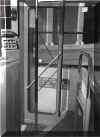 The front entrance showing the Self-Service
Auto Fare Collecting (AFC) Machine just visible to the left. Notice too
the seating
capacity sign for both decks. These AFC
machines were also used on some Red Arrow and LT Merlin Swift Single Deckers.
The front entrance showing the Self-Service
Auto Fare Collecting (AFC) Machine just visible to the left. Notice too
the seating
capacity sign for both decks. These AFC
machines were also used on some Red Arrow and LT Merlin Swift Single Deckers.
 The front (entrance only) doors on the same DMS (note the licence disc holder -
bottom right - visible through windscreen and the AFC centre gangway
partition - bottom left).
The front (entrance only) doors on the same DMS (note the licence disc holder -
bottom right - visible through windscreen and the AFC centre gangway
partition - bottom left).
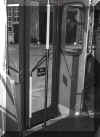
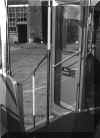 The centre (exit only) doors probably on the same DMS (hence the NO ENTRY sign).
The centre (exit only) doors probably on the same DMS (hence the NO ENTRY sign).

 The door gear for the entry and exit doors respectively.
The door gear for the entry and exit doors respectively.
The following is unidentified - but I think this and the staircase below might be something to do with MCW and South Wales - do you have any clues? Please contact me.
Staircase
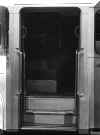 I've received a suggestion
from Basil Hancock regarding this interior. He states "It looks to me to be
in unpainted aluminium finish, and this would correspond with 13
forward-entrance Weymann-bodied AEC Regent Vs delivered to South Wales Transport
in 1958/9." Here is a link to some information and pictures: http://www.freewebs.com/renown40/southwalestransport.htm
I've received a suggestion
from Basil Hancock regarding this interior. He states "It looks to me to be
in unpainted aluminium finish, and this would correspond with 13
forward-entrance Weymann-bodied AEC Regent Vs delivered to South Wales Transport
in 1958/9." Here is a link to some information and pictures: http://www.freewebs.com/renown40/southwalestransport.htm
As always, I am grateful to Basil for his input, that seems very likely correct, but do you have any further suggestions? What do you think? Please write in with your views, thanks (Ed.).
Drivers Cabins
 This driver's mirror set is
unknown. Can you help?
This driver's mirror set is
unknown. Can you help?
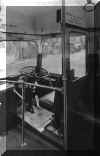 Can
anyone shed more light on this?
Can
anyone shed more light on this?
David Frost suggests that it is almost certainly an AEC Regal IV from Christchurch NZ. The first ones arrived in 1952 and had the same steering wheel as London Transport had on RTs & RFs. The very unusual windscreen shape plus the driver's side window, which is very much larger than normal, makes the cabin particularly distinctive. Additionally, these buses had an LT-style pre-selector and this image shows an RT/RF type pre-selector plainly visible under the steering wheel. Furthermore, the shape of the exterior mirror fits, as does the trim on the screen behind the driver's seat. The note about smoking also suggests a separate exit door, which these buses had.
(I think David is absolutely correct. If you take a look at the Christchurch 1952 Regal IV on this site (first image showing the front entrance with the doors ajar) some similarities can be seen; the handrails (drivers cabin rail off hook), the seat base, the throttle footrest and the large side window. The floor looks different but that may just be the angle of the light. Thanks David. Can anyone add to these observations? Ed.)
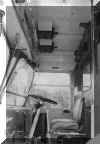
 Lloyd
Penfold points out that the driver's cab shown in these
two pictures are the same. More than probably, a post WW2
Leyland (or very likely BUT - a sales branding of AEC and Leyland products in
the '50's and '60's) single-deck trolleybus. It clearly has two sets
of powered doors (buttons just ahead of the direction indicator switch) and from
the style of window surround it may well be the same vehicle as the last of the
single deck interiors shown above.
Lloyd
Penfold points out that the driver's cab shown in these
two pictures are the same. More than probably, a post WW2
Leyland (or very likely BUT - a sales branding of AEC and Leyland products in
the '50's and '60's) single-deck trolleybus. It clearly has two sets
of powered doors (buttons just ahead of the direction indicator switch) and from
the style of window surround it may well be the same vehicle as the last of the
single deck interiors shown above.
In any case, he says there are many matching features between the cabins below and the single deck above to the Saunders-Roe bodied BUT (Leyland) RETB1 seen in Auckland NZ. The split and angled driver's screen; half drop opening windows in the correct places; the lower-than-the-windows entrance door tops (the emergency handles to open the doors are just visible high up in one of the pictures below); even the large rectangular interior mirror visible at the top of the nearside windscreen and its two support arms match the Saunders-Roe bodies.
Lloyd has seen Saunders-Roe bodies with matching interior window surrounds, including a now-preserved double decker lightweight experimental bus that ran for Birmingham Corporation built at the approximately the same period and believes that these pictures are of trolleybuses bound for New Zealand.
Paul Gourley confirms: The photos are of a SARO body on a B.U.T RETB1/2 chassis and I believe this is number 60 that was fully built whereas most of the others were delivered in kit form to New Zealand to be constructed by the Auckland Transport Board. The Museum of Transport and Technolgy in Auckland are working on number 85 (of the same batch). Forty were supplied and given numbers 60 to 99.
Can anyone shed more light on this?